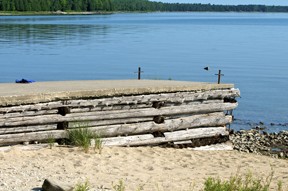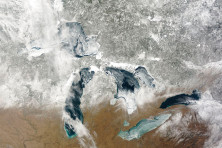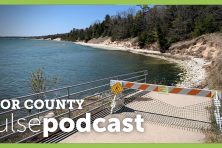Influencing Water Levels
- Share
- Tweet
- Pin
- Share

With water levels estimated to be about a foot and a half below normal in Lake Michigan, this is one example of a dock to nowhere in Door County. Photo by Len Villano.
Lake Michigan-Huron is low – in fact, the Army Corps of Engineers reports June was about a foot and a half below average depths – but there might be a way to fix it.
Fixing it, however, means using engineering to disrupt a natural system, lowering water levels in some lakes in order to raise others and impacting ecosystems throughout the region.
But higher levels mean easier travel for commercial shipping, less dredging for now-shallow harbors and fewer invasive phragmites on Door County shores.
The International Joint Commission (IJC), a group that helps the United States and Canadian governments make decisions about the shared Great Lakes resource, just accepted the International Upper Great Lakes Study (IUGLS) plan for regulating lake levels.
The plan is an updated version of Plan 1977-A, in place since 1977. This revised plan includes information on factors that affect water levels, advice on dealing with climate change and recommends the U.S. and Canada regularly collect data on the lakes.
The IJC is hosting meetings around the region to gauge people’s reactions to the recent study, and one meeting will be held at the Door Community Auditorium in Fish Creek on July 11 at 6 pm.
“People should come out based on their interest in the future of the lakes and look at if we want to let the levels of the lakes vary more as Mother Nature intended, or if we want to do more to manage water levels,” IJC public information officer John Nevin said.
The IUGLS plan
The revised plan lists possible ways the IJC could influence water levels, like slowing water flowing out of Michigan-Huron by installing speed bumps, dikes or turbines in the St. Clair River –projects with price tags ranging from $30 million to $170 million.
While the plan mentions ways to regulate water levels, it doesn’t recommend doing so. Some people want to see stable lake levels, others want to leave them be. And lake levels affect various parts of the Great Lakes region differently. When levels are low, for example, Georgian Bay fisheries in Canada hurt while Saginaw Bay fisheries in Michigan flourish.
Scudder Mackey, ecosystem team leader for the IUGLS, warned that changing lake levels on Michigan-Huron wouldn’t be as easy as it would for other lakes, like Lake Superior.
“Our ability to influence water levels on Lake Michigan-Huron by controlling flows out of Lake Superior is significantly reduced. It’s on the order of 8-10 inches at most,” Mackey said.
That’s because only about 40 percent of Lake Michigan-Huron’s inflow of water comes from the St. Marys river, where water flows from Lake Superior. To significantly change water levels in Michigan-Huron, Mackey said the IJC would have to essentially drain Lake Superior – which means picking one lake over another.
“We had to look at this from a holistic perspective as a dynamic system,” Mackey said.
Before deciding whether to regulate Great Lake water levels, the IJC has to consider the needs of every industry, region and environment. Neither state nor national government can take precedence over another, and each use of the lake holds equal importance.
“There were five or six different components that we had to balance. We were seeking a plan that didn’t adversely impact any of those sectors in a significant way and take importance in the existing plan,” Mackey said.
Mackey focused on the ecological side of the plan, while other groups looked at economics, municipal, navigation and recreational issues.
“Our job was to make sure they didn’t make anything worse,” Mackey said.
But regulating lake levels, thus raising them in Door County, is attractive to some, like John Hammarstrom, harbormaster of the Baileys Harbor town marina.
“Water depth is critical to us,” Hammarstrom said. “I think if there’s a method they could use to control the lake it would be a benefit to all the marinas on Lake Michigan.”
The Baileys Harbor town marina spent $50,000 on dredging this year and still doesn’t have enough water to bring in larger pleasure boats like before. Dredging deeper isn’t an option in Baileys Harbor because they reached the average depth of the harbor, and if they go any deeper, the sand on the lake floor would fill right back in.
But according to Nevin, these low lake levels will continue to fluctuate.
“It’s not permanent,” Nevin said. “It’s not something that’s going to continue getting lower. We’ll see the levels rebound as they did in the past.”
Climate change, something that’s also addressed in the new plan, could affect the Great Lakes in a number of ways. Models that predict how future climate will affect the Great Lakes aren’t conclusive about water levels or weather, just that future climate will bring severe storms and more extreme conditions.
“Over the long term we don’t know if we’re going to have extreme high water, extreme low water or severe storms and changes in the pattern of precipitation and evaporation,” Mackey said. “If we base a regulatory plan on what happened historically, it may not be responsive for these extreme events.”
Public Comment Meeting Held in Door County
The International Joint Commission will hold a meeting at the Door Community Auditorium in Fish Creek on July 11 at 6 pm. The public will have an opportunity to comment on regulating lake levels in Lake Michigan-Huron. Comments can also be submitted by mail to:
International Joint Commission
200 L Street NW, Suite 615
Washington, DC 20440
Or online at http://www.ijc.org/iuglsreport/.
To download a full version of the report, go to http://www.iugls.org



